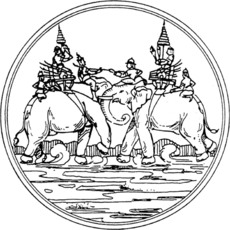Burmese–Siamese War (1563–64)
| Burmese–Siamese War (1563-1564) | |||||||
|---|---|---|---|---|---|---|---|
| Part of Burmese–Siamese wars | |||||||
 War elephants depicted from a later Siam–Burma war. White war elephants such as these were the purported casus belli for the 1563-64 war. |
|||||||
|
|||||||
| Belligerents | |||||||
|
|
Toungoo Dynasty (Burma) |
||||||
| Commanders and leaders | |||||||
|
|
Bayinnaung Mahathammarachathirat Thado Minsaw Binnya Dala |
||||||
| Units involved | |||||||
|
Portuguese mercenaries |
Royal Burmese Army | ||||||
| Strength | |||||||
| Unknown |
Burmese sources: 120,000+ men |
||||||
Toungoo Dynasty (Burma)
Burmese Controlled Thai States including:
Burmese sources:
60,000+ men, 2400 horses, 360 elephants and another army from Lan Na
The Burmese-Siamese War of 1563-1564, also known as the War over the White Elephants, was a war between the Toungoo Dynasty of Burma and the Ayutthaya Kingdom of Siam. It was the second of twenty wars fought between the Burmese and Siamese that lasted well into the 19th century. The cause of the war was an attempt by the Toungoo king Bayinnaung to force the Ayutthaya kingdom into submission under his rule, as part of his campaign that later created the largest empire ever to exist in Southeast Asia. 13 years into Bayinnaung's reign, his second attempt at invasion of Siam and first as king succeeded after an extensive siege of the city of Ayutthaya. Siam became a vassal of the Toungoo Dynasty, this status lasting until a 1568 revolt by Ayutthaya resulting in a short-lived independence.
Following the 1547-49 war with the Toungoo, Ayutthaya king Maha Chakkraphat built up his capital city's defenses in preparation for a later war with the Burmese. The 1547-49 war ended in a Siamese defensive victory and preserved Siamese independence. However, Bayinnaung's territorial ambitions prompted Chakkraphat to prepare for another invasion. These preparations included a census that prepared all able men to go to war. Arms and livestock were taken by the government in preparation for a large-scale war effort, and seven white elephants were captured by Chakkraphat for good luck. News of the Ayutthayan king's preparation spread quickly, eventually reaching the Burmese.
Meanwhile, an attack on the city of Chiang Mai in the nearby Lan Na kingdom by Bayinnaung succeeded in taking the city in 1556. Subsequent efforts left most of northern Siam under Burmese control. This successful invasion resulted in Bayinnaung being given the nickname "Conqueror of Ten Directions". This left Chakkraphat's kingdom in a precarious position, faced with enemy territory to the north and the west.
...
Wikipedia
